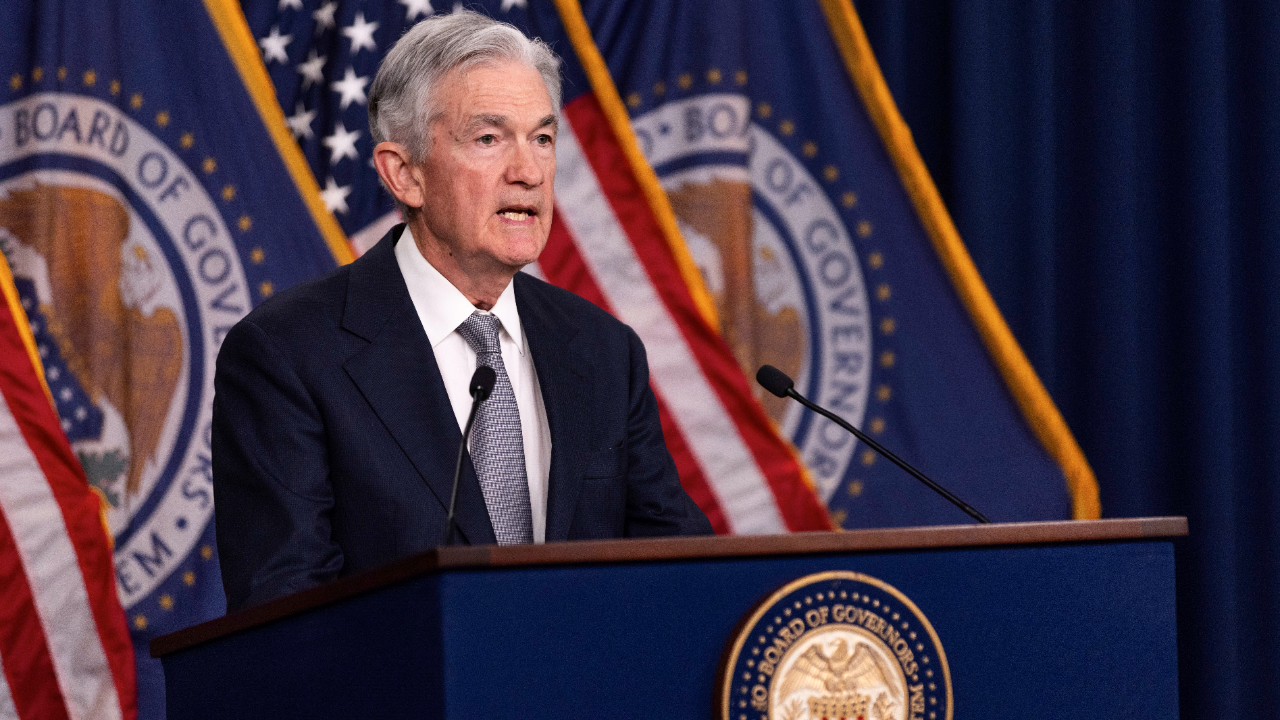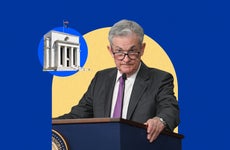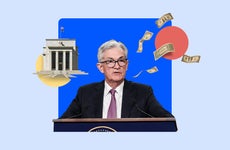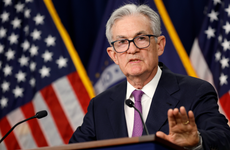Fed keeps interest rates unchanged, sees cuts coming in 2024

The Bankrate promise
At Bankrate we strive to help you make smarter financial decisions. While we adhere to strict , this post may contain references to products from our partners. Here's an explanation for .
The Federal Reserve decided to leave interest rates alone at its final meeting of the year but signaled that it’s officially finished raising interest rates in its historic inflation fight — and could also cut interest rates three times next year.
The Federal Open Market Committee’s (FOMC) decision suggests the Fed’s key benchmark borrowing rate will likely peak at a 22-year high of 5.25-5.5 percent.
Policymakers have been lifting interest rates at a breakneck pace since March 2022, taking their key federal funds rate from a rock-bottom level of near-zero to its current target range in just a 16-month span. Those have been the fastest pace of rate hikes since the 1980s, moves fueled by hopes to drain the economy of the hottest inflation in generations.
So far, the Fed has been making progress without wrecking economic growth. Prices in November rose just 3.1 percent from a year ago, down from the eye-catching rate of 9.1 percent in June 2022 and now just about a percentage point above the level the Fed prefers. All the while, the unemployment rate has held below 4 percent for the longest stretch of time since the 1960s, edging back down to 3.7 percent in November.
With lower inflation seemingly in reach, Fed watchers have been looking for clues on when officials may be willing to start lowering borrowing costs.
In updated projections released along with the Fed’s December decision, not a single Fed official penciled in higher rates from here, suggesting borrowing costs have already peaked. Meanwhile, the Fed penciled in a target range of 4.5-4.75 percent by the end of 2024 — 0.75 percentage point lower than its current level.
By most measures, the Fed’s key interest rate is already exerting the most pressure on the economy in over a decade. Officials also don’t have to raise interest rates anymore from here to slam the brakes on the economy even more. Instrumental to the rate debate is the “real” cost of money, or interest rates minus the overall level of inflation. The more price pressures slow, and the longer borrowing costs stay at their current level, the more the “real” cost of money grows. If the Fed is successful in gradually cooling inflation without spurring a recession, experts say interest rates may be able to ride inflation on the way down.
But policymakers are making it clear that they aren’t at that point yet. Fed officials know inflation can send mixed signals, and they’ve spoken out against the U.S. central bank’s stop-and-go policies that fueled more inflation in the 1970s and ‘80s. Fed Chair Jerome Powell indicated that officials would be willing to start raising interest rates again if the inflation outlook called for it.
Whatever the Fed decides will have major implications for consumers’ finances. The Fed’s rate acts as a lever on the key interest rates throughout Americans’ financial lives, from savings accounts and certificates of deposit (CDs) to credit cards, car loans and home equity lines of credit (HELOCs).
“Nothing in the economy suggests the Fed needs to be in a hurry to cut interest rates in 2024,” says Greg McBride, CFA, Bankrate chief financial analyst. “In a soft-landing scenario, the Fed only needs to trim rates in response to further easing in inflation pressures, just enough to maintain tight policy without loosening it.”
The Fed’s rate decision: What it means for you
Savers
Few groups have benefited from the Fed’s massive rate hikes quite as much as savers. The average annual percentage yield (APY) on a savings account has jumped tenfold, and the yields at the highest-paying banks are hitting the highest since 2007.
Savers can easily find a savings account paying 5 percent APY a year — or more — if they shop around, translating to big gains. Keeping just $1,000 in one of those accounts would give you $50 in interest. Stashing away $10,000, meanwhile, can earn a saver an extra $500 in a year.
Americans who set any amount of cash to the side are missing out on their opportunity to earn one of the only “free lunches” of personal finance if they aren’t keeping those funds in a high-yield account. Those offers could edge lower even before the Fed begins cutting interest rates. Banks often adjust offers when it looks unlikely that officials could raise their key benchmark anymore.
One way to lock in a higher yield for longer could be a CD. The highest-yielding 2-year CDs are offering consumers an APY as high as 5.3 percent, while the top 5-year CDs are offering 4.7 percent a year in interest. When the Fed finishes raising rates, those payouts might not get much better.
But saving isn’t just a rewarding personal financial habit right now. It’s also a crucial one. The odds of a recession aren’t as high as they used to be, dipping to 46 percent from a high of 64 percent just two quarters ago in Bankrate’s latest economists’ survey. Yet, economic uncertainty has been the norm for households in a post-pandemic economy.
Aiming for a six-month emergency fund is a “sleep-well-at-night” fund that could help bridge you through a stint of unemployment or an unexpected expense. Savers should be sure to keep that cash in a liquid and accessible account, so they can utilize it on a moment’s notice.
Borrowers
Emergency funds have another useful purpose: They can keep you from having to rely on a high-interest credit card when unexpected expenses arise.
Borrowers have been slammed since the Fed began raising interest rates. To be sure, financing on a credit card was never cheap. Even when the Fed’s benchmark was at a record low, rates were holding above 16 percent. But credit card debt has grown even more burdensome over the course of the Fed’s 20-month inflation-fighting campaign. The average credit card rate in Bankrate’s survey has held at a record high since the fall of 2022, most recently hitting an annual percentage rate (APR) of 20.72 percent in early October.
The Fed possibly being finished with raising interest rates also doesn’t come with much relief for anyone planning to finance a big-ticket purchase soon. Even though the Fed hasn’t raised interest rates since July, other forms of credit have continued to surge — especially HELOCs. Traditionally a form of lower-cost debt, HELOC rates have surged 1.46 percentage points since the Fed’s last quarter-point increase, topping 10 percent since November, Bankrate data shows. At the start of 2022, they were just 4.24 percent.
But not everyone can time the market. Before locking in a loan, compare offers from multiple lenders. To score lenders’ best rates, concentrate on keeping a strong credit score by paying your bills on time and keeping a healthy credit utilization ratio. The typical rule of thumb suggests using just 30 percent of your available credit.
If you’re trying to eliminate credit card debt, see whether transferring your balance to a balance transfer card with a 0 percent or low-rate APR introductory offer may save you money in the long run and speed up your repayment. You’ll want to form a game plan, though: The longest offers currently last for 21 months.
Homebuyers
After watching mortgage rates surge past 8 percent for the first time since 2000, prospective homebuyers have seen some relief on the financing side. The average 30-year fixed-rate mortgage has dropped 78 basis points since that late-October surge, Bankrate data shows.
Mortgage rates move in lockstep with financial markets. As inflation improves and investors price in the likelihood of rate cuts next year, the 10-year Treasury yield has bounced, falling a similar 75 basis points since hitting a decade-plus high in mid-October.
But if homebuyers were following mortgage rates before the Fed began raising borrowing costs, the dip might not feel like it’s worth much. A $500,000 30-year mortgage would’ve cost $2,089 in principal and interest back when rates were at a record low, according to Bankrate’s mortgage calculator. That monthly payment would now be $3,672 — a 76 percent jump — if a homebuyer had to lock in a 30-year fixed-rate mortgage at its current 7.23 percent level. Falling mortgage rates shave about $200 off of what they would’ve cost when they were hitting 8 percent.
Higher mortgage rates can weigh on Americans’ housing budgets, altering how much house they can afford.
That’s as home prices already make it a difficult time to crack into the market. Rising mortgage rates have done little to quell the pain of expensive home prices. And after declining for seven straight months, home prices are now on the ascent again, rising for eight straight months in S&P CoreLogic’s Case-Shiller Home Price index and notching a new record high.
Keeping a floor on how low prices can go are ongoing inventory issues. The inventory of single-family existing homes could last 3.6 months, data from the National Association of Realtors shows. That’s a marked improvement from a 1.7-month supply in early 2022, but still far below the 6-month supply considered healthy levels for the housing market.
Those challenges don’t just matter for would-be buyers, but renters, too. More potential homebuyers on the sidelines could keep rent costs elevated. Shelter has been one of the key drivers of inflation, and the price of renting a primary residence is up 6.9 percent from a year ago — and 21 percent since the pandemic.
Rate cuts might not also be the complete medicine buyers are hoping for. The housing market is rate sensitive, and many Americans may jump at the opportunity to buy a home if mortgage rates substantially retreat, adding even more upward pressure on home prices. Experts, however, also say it might help the inventory shortage. Existing home sales have plummeted in the current-rate environment, as borrowers who locked in a sub-3 percent mortgage hang onto their rates.
Still, 90 percent of homeowners have a mortgage rate below 6 percent, notes Mark Fleming, chief economist at First American Financial Corporation.
“Even with an improved outlook for mortgage rates, I don’t expect that it’s enough to truly unlock all of that supply,” he says. “We remember getting the 3.5 percent mortgage rate. That anchor bias fades over time, and what I don’t know is how quickly that happens.”
Millions of Americans are still refusing to blink in the face of a tough housing market, continuing to buy homes in a tough market. But if you decide to wait it out, you can still take steps in the right direction toward homeownership. Find ways to boost your income, pay down existing debts and improve your credit, so you’re eligible for lenders’ best rates when you do decide the time is right.
Investors
The prospect of the Fed succeeding at slowing inflation without triggering a devastating recession has excited investors. The S&P 500 closed at a new high for the year on Dec. 1 and repeated that streak the following Friday. The day before the Fed meeting, a rally helped also send the key stock index to the highest level since January 2022.
That could come crashing down if both investors — and the Fed — don’t get the news they’ve been hoping for.
Powell has stressed that the path to 2 percent inflation might not be a straight line. While the Fed’s preferred gauge of inflation hit 3 percent in October, the other main measure from the consumer price index (CPI) showed that prices when excluding food and energy rose from the previous month. So-called “core” CPI has hovered at around 4 percent since August, data from the Department of Labor shows.
That’s keeping the Fed on guard to keep interest rates higher for longer, contradicting investors’ expectations. Investors are betting on 125 basis points of cuts by the end of 2024, CME Group’s FedWatch tool shows.
A tougher-than-expected Fed could jostle markets, causing extra volatility and putting market participants on a bumpy ride. That shouldn’t shouldn’t matter to long-term investors. Stay the course with your retirement contributions, and with a diversified portfolio, you’ll be safe to tune out the boogeyman of the day.
It’s not ‘if’ the Fed will cut interest rates — but ‘when’ and ‘why’
At first glance, Fed watchers might not be able to tell just how much more dovish the Fed’s new projections are.
Back in September, the Fed penciled in one more rate hike, bringing interest rates to a peak target range of 5.5-5.75 percent. That update also showed that officials were expecting to cut borrowing costs by half a percentage point in 2024, moves that would take the Fed’s key rate down to 5-5.25 percent.
Today’s dots show that the Fed now expects one extra rate cut — and one fewer rate hike than before. Taken together, policymakers’ new projections pencil in a federal funds rate that’s half a percentage point lower for 2024 than their previous estimates.
The 2024 pivot fueled a market rally after the Fed’s final meeting of the year. The S&P 500 closed 1.4 percent higher on the news, while the two-year Treasury yield sank 30 basis points, the biggest move since March. After topping 5 percent just six weeks ago, the 10-year Treasury yield dipped to 4.04 percent.
Investors’ bets didn’t stop there. Market participants are now pricing in 1.5 percentage points of rate cuts, after expecting just 1 full percentage point at the start of the week, with the first reduction expected to kick off at the Fed’s second meeting of 2024 in March, according to CME Group’s FedWatch tool.
That’s still more dovish than most Fed officials currently expect. Just one official sees six rate cuts in 2024, the Fed’s new projections show. Still, Powell admitted that Fed officials had a conversation about rate cuts at their rate-setting meeting, he said at the Fed’s post-meeting press conference. That comes not even two weeks after Powell stressed that it was too soon to start talking about rate cuts, in a Dec. 1 address at Spelman College in Atlanta.
“They’re kind of amending that higher-for-longer mantra that they were talking about over the summer,” says Scott Anderson, chief economist and executive vice president at BMO Capital Markets. “Taking that threat of further rate hikes pretty much off the table is a big thing for the markets. But the Fed gave an inch here, but the market is taking a mile.”
Powell didn’t offer any clues on when rate cuts could happen. But Anderson is projecting three cuts to happen at the Fed’s final three meetings of the year: in September, November and then December.
Equally as important as the timing of rate cuts is the cause of them. Market participants had long been expecting that the Fed would eventually have to start cutting borrowing costs. This time around, however, the reasons for the outcome have changed.
Slowing inflation without a major economic slowdown is renewing optimism that the Fed can achieve the once-impossible soft landing.
The Fed seemingly shared those same sentiments in its projections for the unemployment and inflation rates. Fed officials see their preferred inflation gauge hitting 2.8 percent by the end of this year and 2.4 percent by the end of 2024. Excluding food and energy prices, so-called core inflation is projected to hit 3.2 percent by the end of the year and 2.4 percent by 2024. All the while, unemployment is expected to rise only slightly to 3.8 percent by the end of this year and 4.1 percent by the end of 2024.
Those are the most upbeat estimates from Powell & Co. since June 2022. Even just last March, Fed officials penciled in a 4.5 percent unemployment rate, along with 3.3 percent headline inflation and 3.6 percent core inflation.
“It could just be a sign that the economy is normalizing and doesn’t need the tight policy,” Powell said, referring to the reason for rate cuts. “Inflation has eased from its highs, and this has come without a significant increase in unemployment. That’s very good news.”
Related Articles

Will stubborn inflation force the Fed to raise interest rates again?

Survey: Fed won’t begin cutting interest rates until 2024 as officials keep tackling inflation

Fed keeps interest rates at 22-year high as economy stays surprisingly strong

Fed keeps interest rates steady, sees only one cut this year despite slowing inflation